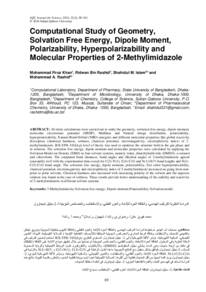وثيقة
Computational study of geometry, solvation free energy, dipole moment, polarizability, hyperpolarizability and molecular properties of 2-methylimidazole.
المعرف
https://doi.org/10.24200/squjs.vol21iss2pp89-101
المصدر
Sultan Qaboos University Journal for Science. v. 21, no. 2, p. 89-101.
المساهمون
عناوين أخرى
الدراسة النظرية للتركيب الهندسي، والطاقة الحرة للإذابة، والعزم القطبي، والإستقطاب، والخصائص الجزيئية لـ 2-ميثيل ايميدازول.
الدولة
Oman.
مكان النشر
Muscat.
الناشر
College of Science, Sultan Qaboos University.
ميلادي
2016-12-01
اللغة
الأنجليزية
الموضوع
الملخص الإنجليزي
Ab initio calculations were carried out to study the geometry, solvation free energy, dipole moment, molecular electrostatic potential (MESP), Mulliken and Natural charge distribution, polarizability, hyperpolarizability, Natural Bond Orbital (NBO) energetic and different molecular properties like global reactivity descriptors (chemical hardness, softness, chemical potential, electronegativity, electrophilicity index) of 2-methylimidazole. B3LYP/6-31G(d,p) level of theory was used to optimize the structure both in the gas phase and in solution. The solvation free energy, dipole moment and molecular properties were calculated by applying the Solvation Model on Density (SMD) in four solvent systems, namely water, dimethylsulfoxide (DMSO), n-octanol and chloroform. The computed bond distances, bond angles and dihedral angles of 2-methylimidazole agreed reasonably well with the experimental data except for C(2)-N(1), C(4)-C(5) and N(1)-H(7) bond lengths and N(1)-C(5)-C(4) bond angle. The solvation free energy, dipole moment, polarizability, first order hyperpolarizability, chemical potential, electronegativity and electrophilicity index of 2-methylimidazole increased on going from non-polar to polar solvents. Chemical hardness also increased with increasing polarity of the solvent and the opposite relation was found in the case of softness. These results provide better understanding of the stability and reactivity of 2-methylimidazole in different solvent systems.
ISSN
2414-536 X
الملخص العربي
أُجريت حسابات أولية لدراسة هندسة 2-ميثيل إيميدازول، وطاقته الحرة، وعزم ثنائي القطب، والجهد الكهروستاتيكي الجزيئي (MESP)، وتوزيع الشحنة الطبيعية وموليكن، وقابليته للاستقطاب، وقابليته للاستقطاب الفائق، وطاقة مدار الرابطة الطبيعية (NBO)، وخصائصه الجزيئية المختلفة، مثل أوصاف التفاعلية الشاملة (الصلابة الكيميائية، والليونة، والجهد الكيميائي، والسالبية الكهربية، ومؤشر المحبة للإلكترون). واستُخدم مستوى نظرية B3LYP/6-31G(d,p) لتحسين بنية المركب في الطور الغازي وفي المحلول. وحُسبت طاقة المذيب الحرة، وعزم ثنائي القطب، والخصائص الجزيئية بتطبيق نموذج كثافة المذيب (SMD) في أربعة أنظمة مذيبات، وهي: الماء، وثنائي ميثيل سلفوكسيد (DMSO)، ون-أوكتانول، والكلوروفورم. توافقت مسافات الروابط المحسوبة، وزوايا الروابط، وزوايا ثنائي السطوح لـ 2-ميثيل إيميدازول بشكل معقول مع البيانات التجريبية، باستثناء أطوال الروابط C(2)-N(1)، وC(4)-C(5)، وN(1)-H(7)، وزاوية الرابطة N(1)-C(5)-C(4). ازدادت طاقة الإذابة الحرة، وعزم ثنائي القطب، وقابلية الاستقطاب، وقابلية الاستقطاب الفائق من الدرجة الأولى، والجهد الكيميائي، والسالبية الكهربية، ومؤشر المحبة للإلكترون لـ 2-ميثيل إيميدازول عند الانتقال من مذيبات غير قطبية إلى مذيبات قطبية. كما ازدادت الصلابة الكيميائية مع زيادة قطبية المذيب، ووُجدت علاقة عكسية في حالة الليونة. تُقدم هذه النتائج فهمًا أفضل لاستقرار وتفاعلية 2-ميثيل إيميدازول في أنظمة مذيبات مختلفة.
قالب العنصر
مقالات الدوريات

